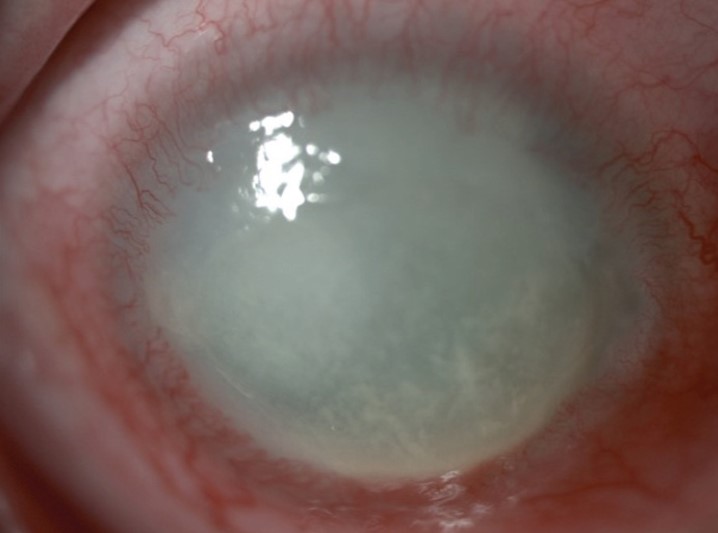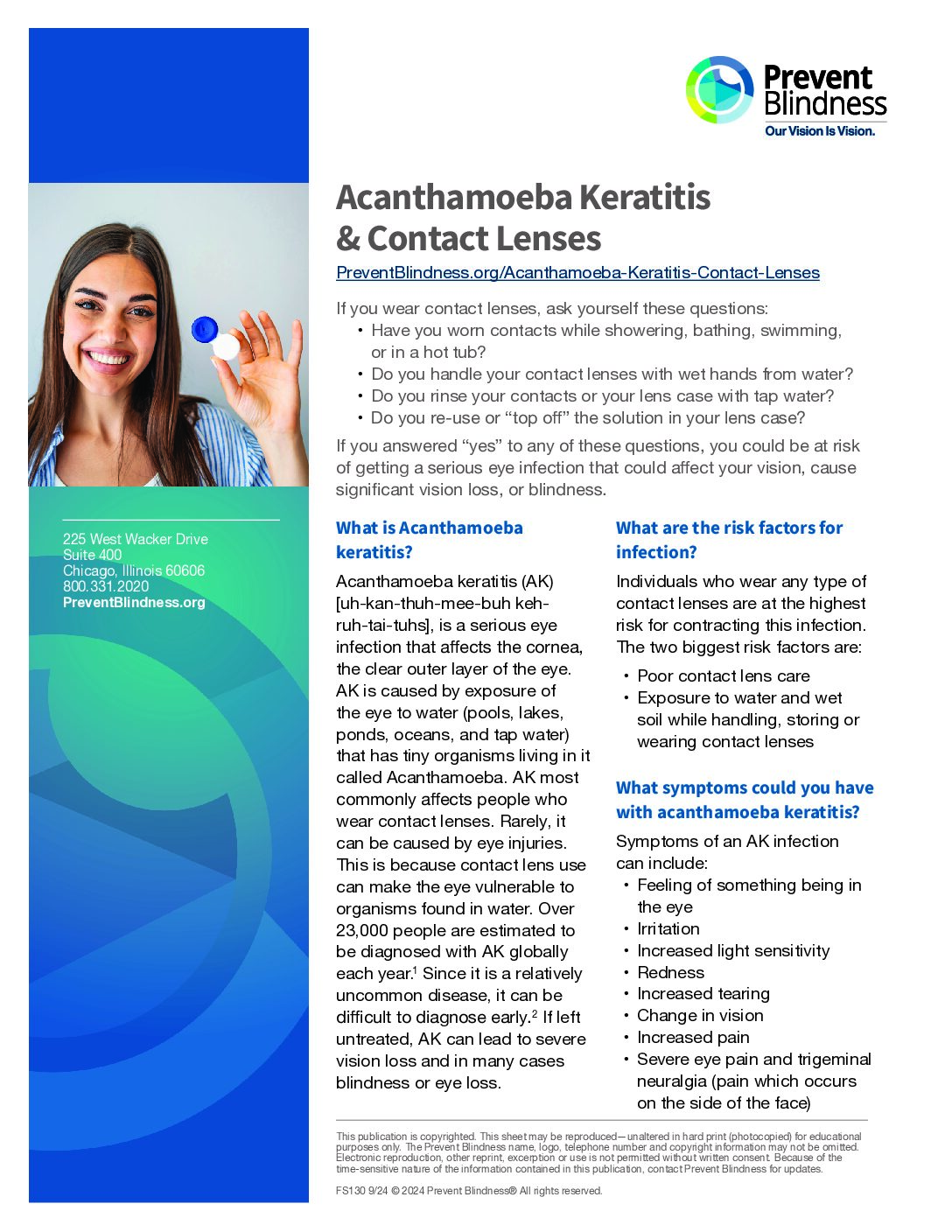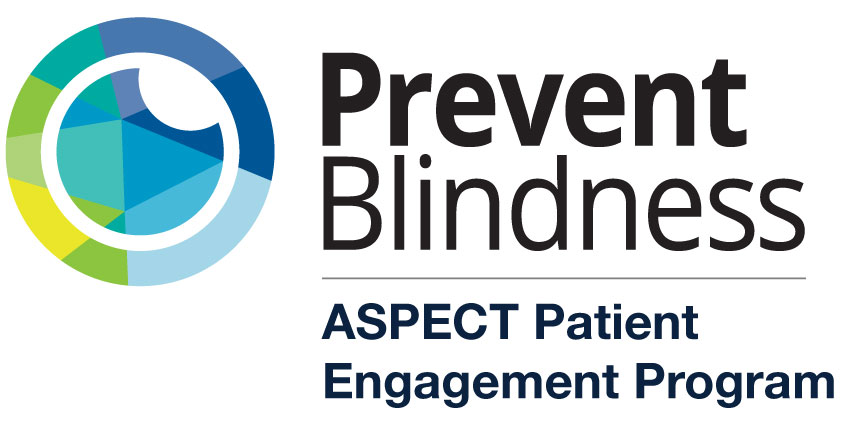If you wear contact lenses, ask yourself these questions:
If you answered “yes” to any of these questions, you could be at risk of getting a serious eye infection that could affect your vision, cause significant vision loss, or blindness.
What is Acanthamoeba keratitis (AK)?
Acanthamoeba keratitis (AK) [uh-kan-thuh-mee-buh keh- ruh-tai-tuhs], is a serious eye infection that affects the cornea, the clear outer layer of the eye. Acanthamoeba keratitis is caused by exposure of the eye to water (pools, lakes, ponds, oceans, and tap water) that has tiny organisms living in it called Acanthamoeba. AK most commonly affects people who wear contact lenses. Rarely, it can be caused by eye injuries. This is because contact lens use can make the eye vulnerable to organisms found in water. Over 23,000 people are estimated to be diagnosed with AK globally each year. Since it is a relatively uncommon disease, it can be difficult to diagnose early. If left untreated, AK can lead to severe vision loss and in many cases blindness or eye loss.
 Lorenzo-Morales et al 2015-10.051/parasite/2015010
Lorenzo-Morales et al 2015-10.051/parasite/2015010
Parasitic (Acanthamoeba) infection
What are the risk factors for Acanthamoeba keratitis infection?
Individuals who wear any type of contact lenses are at the highest risk for contracting this infection. The two biggest risk factors are:
Poor contact lens care
Exposure to water and wet soil while handling, storing or wearing contact lenses
What symptoms could you have with Acanthamoeba keratitis?
If you experience any of these symptoms, please remove your contact lenses and consult an eye doctor immediately. It is important to tell them any symptoms you are experiencing and if you are a contact lens user and that your lenses may have been in contact with water.
How can I prevent infection from Acanthamoeba keratitis?
The best way to prevent eye infections from AK is to always follow proper contact lens care guidelines as prescribed by your eye doctor. The following are key tips for contact lens care:
Wash hands: Before handling contact lenses, wash your hands with soap and water, then rinse and dry them completely with a lint-free
Remove contact lenses: Remove contact lenses before any activities with water, such as showering, bathing, swimming, or hot tub use.
Do not use water: Contact lenses should never be rinsed with or stored in water (both tap or sterile water).
Follow use and care instructions: Wear and replace contact lenses as directed by your eye doctor. Using daily disposable contact lenses and throwing them away each day is often the safest way to avoid infection.
New solution: Use fresh disinfecting solution to clean, rub, and rinse your contact lenses each time you remove them – even if the solution you are using is a “no-rub” Do not re-use the old solution or “top off” the solution in your lens case. Remove this solution thoroughly before adding fresh solution.
Clean contact lens case: Contact lens cases should always be cleaned with fresh solution – not water. Then leave the empty case open to dry. Replace lens cases regularly- at least every three months. Do not use cracked or damaged lens Lens cases can be a source of contamination and infection.
Location: Consider keeping your contact lenses outside the bathroom, to reduce the risk of water contamination.
Swimming and contact lenses
We encourage people not to swim with contact lenses in at all due to the risk of Acanthamoeba keratitis. Many people have contracted AK by swimming with contact lenses in. You can get prescription googles. If you do swim with contact lenses, your best option is to use swimming goggles or a correctly fitted snorkeling mask to prevent water coming close to your eyes, which will reduce but not eliminate the risk of infection. Throw away these contact lenses right after.

How is Acanthamoeba keratitis diagnosed?
Early diagnosis is key for effective treatment of AK. Acanthamoeba keratitis is often incorrectly diagnosed as bacterial or viral keratitis. This can cause poor treatment and pain management. For example, many cases of AK have been misdiagnosed as herpes simplex keratitis which is treated with steroids. This treatment can hide Acanthamoeba keratitis symptoms, and once stopped the infection can become worse.
What are the treatment options for Acanthamoeba keratitis?
If you are receiving treatment for an eye condition and symptoms continue, especially increased pain and light sensitivity or worsening vision, then return to your eye doctor as soon as possible. If you are not already being seen by a cornea specialist, you should make every effort to see a cornea doctor that specializes in infections of the cornea.
Diligence and early detection will increase the chances of successful treatment and prevent vision loss.
Acanthamoeba keratitis is treated with both eye drops and oral medications. Anti-amoebic [uh-mee-buhk] eye drops and pain killers, eye drops, pain killers, and other necessary medications will be prescribed your eye doctor. You will often be on treatment for several weeks and in many cases, several months.
Acanthamoeba keratitis treatment may initially cause your inflammation to get worse, up to a few This is part of the healing process3.
If your infection does not improve with the above treatments, you may need to undergo a corneal transplant, where all or part of the cornea is removed and then replaced with healthy donor tissue. In some cases, the infected eye may need to be removed.
Even if treated, AK may be in the hibernating stage and resist treatment. This could cause a relapse in infection or potential drug resistance, so be sure to follow up with your eye doctor.
Is there anything you can do if you have lost vision to Acanthamoeba keratitis?
If you or someone you know has lost some sight due to AK, there are professionals who can help you with this transition, including low vision specialists. A low vision specialist may help you determine tools and skills that can assist you in performing everyday activities with greater ease by maximizing the use of the vision you still have. This can be done with lenses, lighting, assistive technology or devices, and visual and non-visual skills. You will undergo a full vision evaluation, which will also include education, and counseling to support your mental wellness.
A low vision specialist will help determine the right plan based on your needs. Ask your eye doctor to recommend a low vision specialist.
Visit these support resources if you have lost some sight due to AK
How does AK affect mental health?
AK can cause loss of vision. For some, loss of vision can lead to feelings of depression, anxiety, and loss of independence.
Some individuals may notice a change in their desire to socialize with others, need for isolation in dark rooms, or increased frustration with the additional time it may take to accomplish tasks of daily living. Not everyone who has vision loss will experience mental health symptoms, but if you do, there is help available.
To learn more about your mental health as you deal with AK, check out the following resources:
Centers for Disease Control and Prevention (CDC): The Mental Health of People with Disabilities
American Psychological Association: Depression
National Alliance on Mental Illness (NAMI): Signs and symptoms
More Resources
The Facebook Acanthamoeba Keratitis Support Group
Are you, or someone you know, experiencing Acanthamoeba Keratitis? Know that you are not alone. Through this dedicated support group, you will find a safe space where you can share your experiences and connect with others who understand. Gain valuable insights from real patient experiences and learn how to advocate for your proper care.
Centers for Disease Control and Prevention: Acanthamoeba Keratitis






